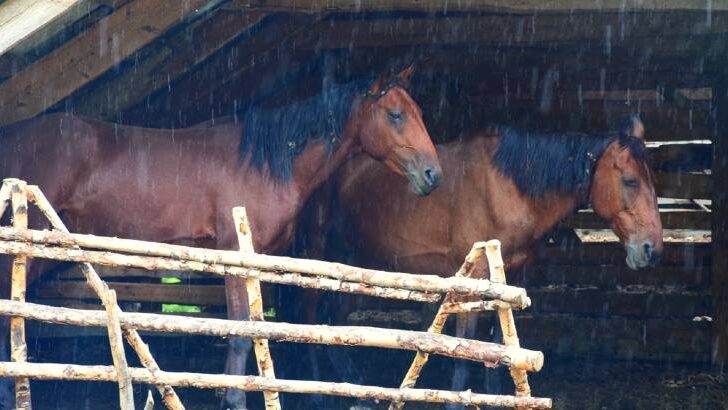Affiliate Disclaimer
As an Amazon Associate I earn from qualifying purchases. It helps me keep the website going. Thank you for your support.
When it starts to rain, we normally run for cover – whether that is indoors, under an umbrella, or reaching for a waterproof coat. We don’t like being cold and wet! But do horses need shelter from the rain, just like we do? After all, wild horses survived outside without a fancy stable or a doting owner.
Horses should always be provided with shelter from the rain. This is so that they can stay safe, dry, and warm during bad weather. Most horses will seek out shelter during periods of rain, as once their coat is wet it becomes more difficult to stay warm.
Domestic horses can only use what is provided for them. Without any form of shelter, horses will struggle during extreme high and low temperatures, as well as in the wet. Read on to learn more about why horses need shelter from the rain, and what sort of shelters are best.
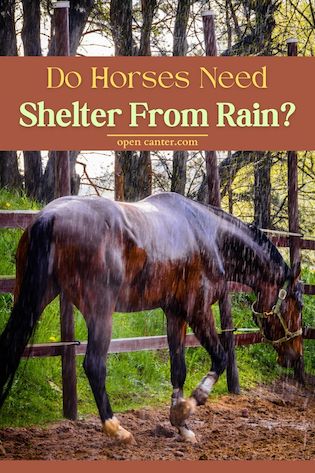
Do Horses Need Shelter to Stay Dry?
Horses can keep their skin dry without shelter, but only if the rain is light and lasts a short time. A horse’s coat contains oils that help to shed water. Additionally, the surface layer of the horse’s skin is also designed like a ‘waterproof coat’. This system also works very well with dry snow, as the oils in the coat ensure the snow doesn’t soak into the hair and skin.
Issues arise during long periods of rain or sleet, especially when the horse has no shelter. Once the hair gets wet, it loses the ability to ‘fluff up’ and provide insulation. This is often when horses will resort to shivering.
Horses who have access to shelter will commonly seek it out during rain. There are occasions when some horses choose to stand out in the rain. If the weather is not cold and windy, some horses enjoy the sensation of the rain. Alternatively, the horse may feel a greater need to stand near other horses, than to be alone under shelter.
Do Horses Need Shelter to Stay Warm?
Horses are much better equipped than humans when it comes to coping with the cold. When humans start to feel cold, it has to be about three times colder for horses to feel the cold. They have a variety of techniques to help themselves keep warm. However, horses will always seek shelter to help them stay warm and to block wind and rain. (source)
Coming into winter, horses grow a new coat that has longer hairs. This is referred to as a winter coat and is triggered by the length of daylight becoming shorter. When the days become longer, the horse sheds its winter coat to prepare for warmer weather.
When it is cold, the hairs on the horse stand up, giving the horse a very fluffy look. This traps tiny air pockets between all the hairs and provides insulation to the horse. This process is known as piloerection. This is also seen in humans when the hairs on your arms and legs stand up when you are cold.
Horses have also evolved to have an internal heater; due to the way they digest their food. Fiber-based feeds, like hay and grass, are digested via fermentation. Fermentation is a slow process that also produces heat. Because the diet of most horses consists of mostly hay or grass, they can keep themselves warm.
The horse can also adjust their circulatory system to help retain heat. When blood passes through blood vessels just under the skin, heat is lost to the cooler air around the horse. A process called vasoconstriction shrinks the blood vessels that are near the skin. This means less blood can circulate in this area, resulting in less heat loss. (source)
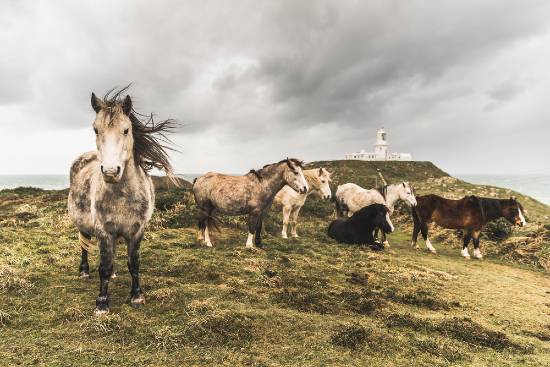
Do Horses Shiver to Keep Warm?
Like humans, horses also shiver when they are cold. Shivering helps to convert energy stored in the body into heat by rapidly contracting and relaxing muscles. Horses might also move or run around to help increase blood flow to warm themselves up. If kept in groups, they might huddle together to share warmth.
Shivering can be effective as a short-term solution to warm the horse up. However, it cannot be sustained for long periods of time as the horse will run out of energy. If you find a horse that has been shivering for a long period of time, they will likely appear exhausted. They will need your help to dry off and warm up.
Do Horses Need Shelter From Other Types of Weather?
Horses will seek shelter during other types of weather, not only when it is raining. In warm weather, shelter helps the horse to cool down. Getting out of the sun also means they can avoid getting sunburnt. Additionally, if the horse is using a shelter, it is less likely to be bothered by flies or other biting insects.
Horses will also seek shelter from strong winds. If shelter is sparse, most horses will face their hindquarters towards the wind and lower their heads. This is to provide some protection to the horse’s head and ears.
During storms, some horses prefer to be out in the open. They may seek shelter under trees rather than in a purpose-built shelter. This is because the noise of rain or hail on the roof can be very loud and frightening.
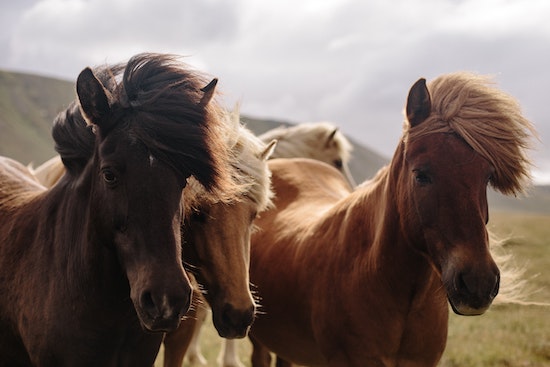
What Happens if Horses Don’t Have Shelter From the Rain?
Even though horses evolved to cope with poor weather, they can still become ill from being out in the rain. Additionally, younger and older horses, as well as those with existing conditions, are more likely to be affected by rain.
If young, old, or compromised horses don’t have shelter from the rain, they will struggle to keep warm. They often don’t have as much muscle or fat in reserve, which means they have less insulation and energy to keep warm. Additionally, older horses commonly have poor teeth. This means they cannot consume as much of the fibrous feed that is required to gain heat from digestion.
Rain scald, or rain rot, is a skin condition that often occurs during periods of extended rainfall. It is easier for bacteria to infect the skin when it is moist and soft. This condition can be worsened by the horse coating itself in a layer of mud when it rolls. It can also occur when horses are repeatedly rugged while their coat and skin are still wet or sweaty.
Rain scald can cause hair loss, to the extent that all the hair along the back and hindquarters are gone. In severe cases, the affected area may become scabby or ooze. Horses with rain scald are usually unable to be ridden until the condition has healed. Keeping the horse’s coat clean and dry helps to deter rain scald.
Similar to rain scald, horses can also develop greasy heel. Also known as mud fever, this is where bacteria infect the skin of the heels and lower leg. Greasy heel is more difficult to treat as it can be hard to limit contact with wet grass or mud. (source)
What Sort of Shelter Does My Horse Need?
There are a few different options when it comes to providing shelter for horses. As most horses live outside, the shelter needs to be available for free access in the horse’s field.
Trees or bushes offer a relatively good option when it comes to shelter. Trees will usually need to be planted in rows or groups to provide maximum shelter. They offer shade with airflow in warm weather and some shelter from wind or rain. However, trees won’t provide complete protection for your horse in wet weather. They also have the risk of falling limbs and are not an instant solution if you need to plant them.
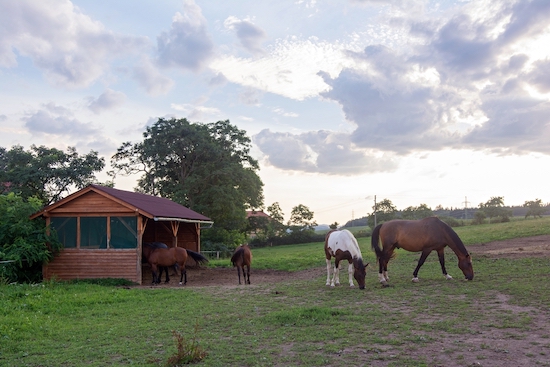
Open-sided field shelters are popular. These may be simply a roof with no walls or a three-sided structure. Some shelters are made from shade cloth strung between posts. These types of shelters provide more protection for the horse, provided they are built correctly. However, shelters with walls can become hot in warm weather due to a lack of airflow.
The shelter needs to be large enough to accommodate all the horses in the field. Keep in mind that dominant horses may ‘claim’ the shelter and not let their herd mates enter. These situations require a large shelter, perhaps in a rectangular shape.
The shelter also needs to be built to give shelter from cold winds. Before building, take note of which way the wind commonly blows. Build the back wall of the shelter facing the direction the wind comes from for maximum protection.
Some owners have barns or stables, separate from the horse’s field. This can work well as the horse can be brought into the stable during bad weather. However, stables require more maintenance, and some horses are more anxious when contained indoors. (source)
Final Thoughts
Horses need shelter from the rain to ensure that they maintain good physical condition and do not become ill. It is even more important that young, old, and ill horses have access to shelter, as they are more likely to become ill from exposure to bad weather. Shelter can be as simple as some trees, or can it be a building like a three-sided shelter or a stable.

